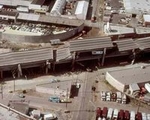
Worksheets and No Prep Teaching Resources
Reading Comprehension Worksheets
Earthquakes

Earthquakes
 Worksheets and No Prep Teaching Resources Reading Comprehension Worksheets Earthquakes |
 Earthquakes |
| edHelper's suggested reading level: | grades 5 to 7 | |
| Flesch-Kincaid grade level: | 10.71 |
|
Shake, Rattle, Richter!
By Trista L. Pollard |

|
 1 When people think of earthquakes, they usually think of the Richter scale. However, you may be surprised to know that measuring the effects of earthquakes has been a hot topic among seismologists for centuries. Although Dr. Charles Richter is one of the most famous seismologists, there were many that came before him.
1 When people think of earthquakes, they usually think of the Richter scale. However, you may be surprised to know that measuring the effects of earthquakes has been a hot topic among seismologists for centuries. Although Dr. Charles Richter is one of the most famous seismologists, there were many that came before him. |
Create Weekly Reading Books
Prepare for an entire week at once! |
| Leave your feedback on Shake, Rattle, Richter! (use this link if you found an error in the story) |
 |
Earthquakes
|
 |
Science
|